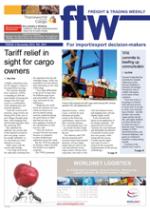SA Revenue Service’s
Customs Modernisation
Programme (CMP) has
substantially impacted the
way trade is conducted in
South Africa.
Introduced in 2009,
its goal was to achieve
significant improvements in
operational efficiencies for
both Customs and traders –
and the key to this has been
moving from a complex,
paper-based and labourintensive
environment to a
simplified, automated and
electronic one.
Underpinning this is an
enhanced risk engine that
has allowed Sars to focus
on higher risk consignments
while allowing legitimate
and lower-risk imports and
exports to move quickly
through the country’s
borders.
The first major change
under CMP was the
introduction in November
2010 of clearance by
Customs procedure to align
all customs information
requirements to version
3 of the World Customs
Organisation (WCO)
Customs Data Model.
This saw the migration
from the use of purpose
codes on declarations to
procedure category and
procedure codes (CPCs). It
had the effect of decreasing
unnecessary administrative
tasks and increasing the
tracking and tracing ability
of declarations throughout
their lifecycle and across the
supply chain.
The second phase was
introduced in June 2011
and was implemented
incrementally during the
year at all the ‘international’
(non-Sacu) Customs offices.
It saw the introduction of an
advanced case management
system, an enhanced
inspection process, the
electronic submission of
supporting documents, an
electronic release system
and the establishment of
four centralised hubs where
all back-office processing
now takes place. Towards
the end of 2011, a mobile
inspection solution was also
introduced, further reducing
inspection turnaround
times. It saw the use of
iPods linked to the Sars
system during physical
inspections which was a
first for Sars.
The focus then shifted
to the Botswana, Lesotho,
Namibia and Swaziland
(BLNS) border posts, where
all of these and a few other
changes were introduced
in February this year to
help facilitate the speedier
movement of trucks through
the land borders.
The CMP also saw
changes in Sars policies to
cater for the abolition of
the general 70707070 code,
and the requirement for all
“foreign”-based importers
and exporters to register as
“foreign principals” and to
conduct business with Sars
by using South Africanbased
“registered agents”.
Coupled with electronic
receipt of declarations,
Customs also introduced
electronic release messages
on EDI and release
notifications at land borders
(CN1 and CN2), cutting
out the need for stamped,
paper-based release
notifications. This means,
in most instances, there is
now an entirely automated,
paperless process for trade.
By the end of June 2012,
all 17 BLNS border posts
had implemented these
changes, with trade starting
to see the benefits. Now the
average time for Customs
to process a declaration can
be anywhere from a few
seconds, if there are no stops
by the risk engine, to less
than 30 minutes
The average time taken
for cargo to move through
ports of entry or exit now is
just 28 minutes. In the past
this could take anywhere
between a few hours to a
day or two, especially if an
inspection was still needed.
For example, traders using
Kopfontein border post
would first have to submit
their declarations at the
Sars Zeerust office where
they would be manually
processed before the truck
could go to the border post
some distance away. Now
everything can be done
electronically by the trader
before the truck even leaves
for the port.
A large registration drive
during these rollouts also
saw the number of people
doing business with Sars
electronically through
Electronic Data Interface
(EDI) increase dramatically.
In January 2012, before
Release 3, 95% of trade at
land borders were using EDI
for exports – at the end of
July it was 98%; for imports
it was 49% in January and
86% in July.
“To sum up, in just over a
year we have rolled out new
processes, an advanced case
management system and a
state-of-the art risk profiling
tool to all sea, air and land
ports,” said Rae Cruikshank,
Sars group executive,
Customs operations.
“Not only that, all our
land borders have enhanced
infrastructure to ensure 24/7
accessibility, WiFi and iPod
capability to enable Customs
officers to finalise cases
wherever they are in the
border post – a first in the
world,” said Cruickshank.
“Now 2D bar coding
is effectively being used
to ensure that goods are
appropriately declared
before they enter control
areas and, more importantly,
all Customs formalities are
finalised before the goods
leave the control area.
Centralised processing has
enabled us to concentrate
scarce skills and apply
them more effectively
over a larger population of
declarations. And we now
have a centralised view
of national risk which has
positively impacted on our
ability to effectively mitigate
the risks."
INSERT
‘The average time
taken for cargo to
move through ports
of entry or exit now is
just 28 minutes.’
CAPTION
Rae Cruikshank … ‘declarations
can be processed in a few
seconds.’

